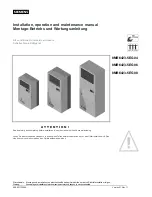
8
Blower Speed
For optimum system performance and comfort, it may be
necessary to change the factory speed setting. See
WARNING:
To avoid electric shock, personal injury, or death,
turn off the electric power at the disconnect or the
main service panel before making any electrical
connections.
CAUTION:
Label all wires prior to disconnection when
servicing controls. Wiring errors can cause
improper and dangerous operation. Verify proper
operation after servicing.
CAUTION:
To avoid personal injury or property damage,
make certain that the motor leads cannot come
into contact with any metal components of the
unit.
1. Disconnect all electrical power to the unit and remove the
service panel.
2. Locate the orange and red wires terminated to the blower
motor.
NOTE:
The orange wire controls cooling operation
and the red wire controls the heating operation.
3. Verify the required speed from the airflow data found in
. Place appropriate wire on the appropriate
motor speed tap for the required airflow.
4. Check all factory wiring as shown in the wiring diagram and
inspect the connections to make sure none of them loosened
during shipping or installation.
START UP & ADJUSTMENTS
Pre-Start Checklist
The following check list should be observed prior to starting
the unit.
√
Verify the unit is level and allows proper condensate drainage.
√
Verify the outdoor coil and top of the unit are free from
obstructions and debris, and all equipment access/control
panels are in place. Unit must be installed with the proper
clearances shown in
√
Verify that the duct work is sealed to prevent air leakage.
√
Verify that the line voltage power leads are securely connected
and the unit is properly grounded. Check the condenser fan
to make sure it turns freely.
√
Verify the thermostat is wired correctly and installed in a
proper location. Make sure the low voltage wires are securely
connected to the correct leads on the low voltage terminal
strip.
√
Verify that the power supply branch circuit overcurrent
protection is sized properly.
√
To achieve rated capacity and efficiency the compressor must
be exposed to refrigerant for at least 24 hours prior to running.
After unit startup, the compressor must run for a minimum of
12 hours.
Start-Up Procedure
CAUTION:
If the unit is equipped with a crankcase heater,
allow 24 hours prior to continuing the start up
procedures to allow for heating of the refrigerant
compressor crankcase. Failure to comply may
result in damage and could cause premature
failure of the system. This warning should be
followed at initial start up and any time the power
has been removed for 12 hours or longer.
The control circuit thermostat may consist of an anti-short cycle
timer that will not let the compressor re-start before 5 minutes
have elapsed.
1. Set the system mode to OFF and the temperature mode to
its highest setting.
2. Turn power on at the disconnect switch.
3. Set the system mode to ON or COOL.
4. Set the temperature mode below room temperature. Verify
that the indoor blower, outdoor fan, and compressor energize
and the cooling function starts.
5. Verify the discharge air grilles are adjusted and the system
air is balanced.
6. Verify the duct work has no air leaks.
7. Verify the condensate drain is installed correctly and functions
properly.
8. Set the temperature mode above room temperature. The unit
should stop.
9. Instruct the homeowner on unit and thermostat operation and
filter servicing.
Air Circulation
Leave the thermostat system mode on OFF, and set the fan
mode to ON. Blower should run continuously. Check the air
delivery at the supply registers and adjust register openings for
balanced air distribution. Examine ducts for leaks or obstruction
if insufficient air is detected.
Set the thermostat fan mode to AUTO. The blower should stop
running.
System Cooling
Set the thermostat’s system mode to COOL and the fan mode
to AUTO. Lower the thermostat temperature selector below the
existing room temperature. Allow the cooling system to operate
for several minutes and check for the discharge of cool air at
the supply registers.
System Heating
(Available only when Electric heat is supplied) Set the
thermostat’s system mode to HEAT and the fan mode to either
AUTO (intermittent air) or to ON (continuous air). Raise the
thermostat’s temperature selector above the existing room
temperature and check the following:
1. The compressor and outdoor fan should not run.
2. The blower will run according to the thermostat’s fan mode
setting.


































